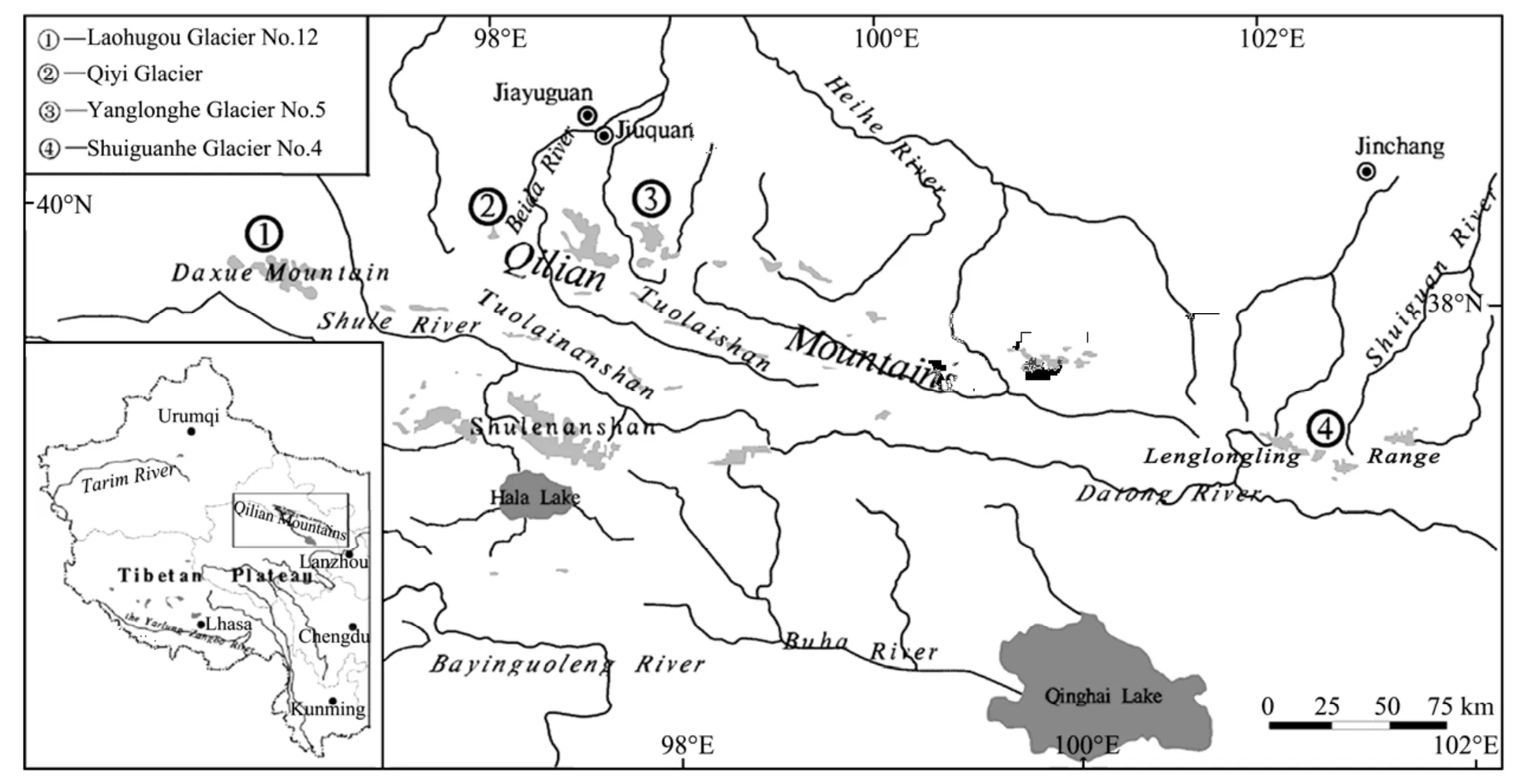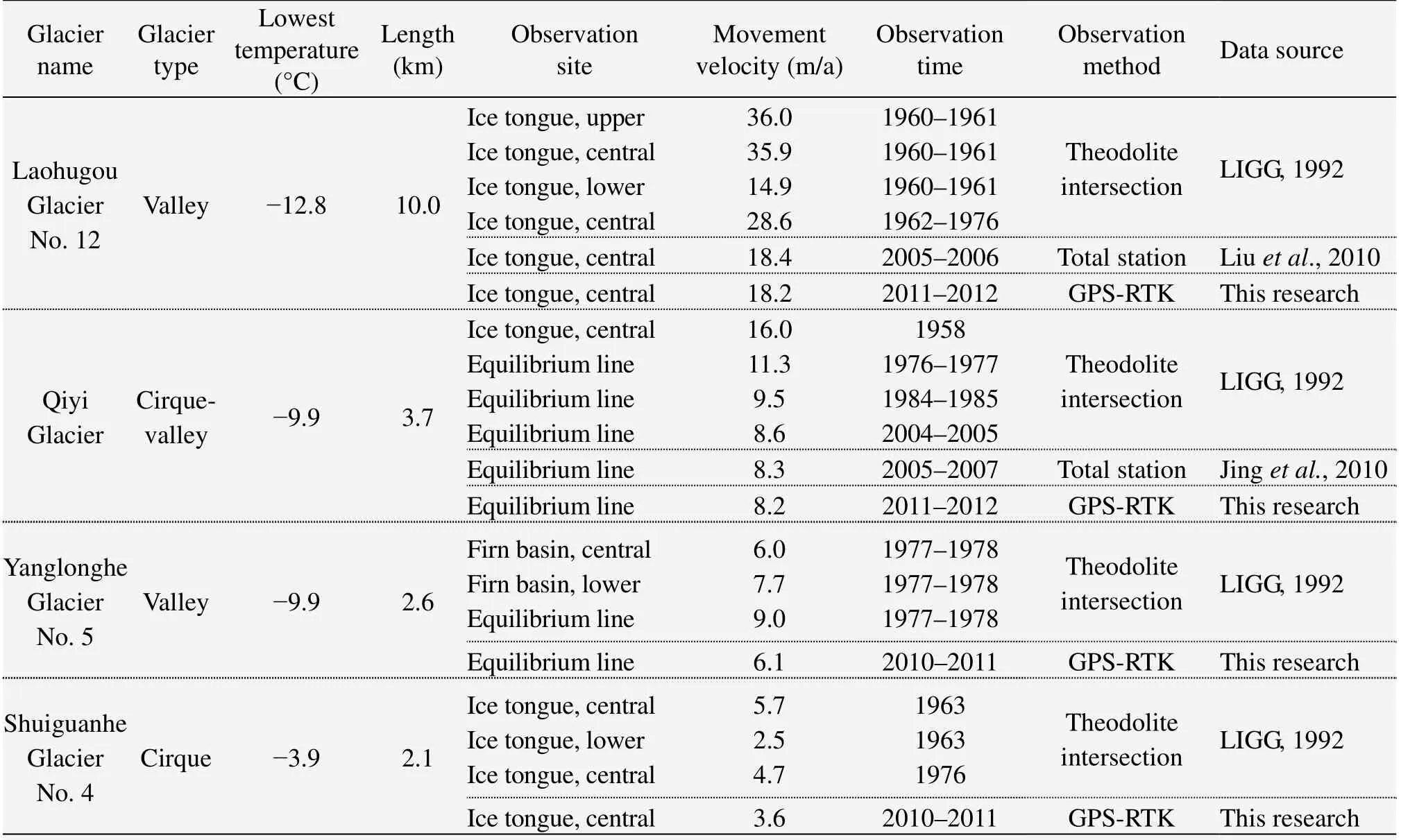Movement and variation of four typical glaciers in the Qilian Mountains,northwestern China
ZheFan Jing,Kun Wang ,Li Liu
Key State Laboratory of Cryosphere,Cold and Arid Regions Environmental and Engineering Research Institute,Chinese Academy of Sciences,Lanzhou,Gansu 730000,China
1 Introduction
Climate warming is the key issue of climate change.Against the background of global warming,the cryosphere,as an important constituent of the global climate system,is undergoing a dramatic change.Cryosphere changes influence the climate system as well as water resources,ecological environments,snow-ice disasters,tourism resources,and different kinds of construction projects.
The Qilian Mountains(94°10′–103°04′E,35°50′–39°19′N)are located at the northeastern edge of the Tibetan Plateau.They consist of more than 800 km of northwest-trending,alternating mountains and valleys.The average height of the Lenglongling Range,the eastern section,is 4,860 m.The altitude of the mountains increases gradually from east to west.For example,Daxue,Shulenanshan,and Tuergendabanshan mountains,located in the west,have peak elevations of between 5,300 and 5,600 m a.s.l..The elevation of Tuanjie Peak,which is part of the Shulenanshan Mountain,has a peak elevation of 5,808 m a.s.l.and is the highest peak of the Qilian Mountains.
Under the influences of westerly showery precipitation and the rainfall from the East Asia Monsoon via the east side of the plateau,precipitation in the Qilian Mountains shows a decreasing trend from east to west during the past several decades.That is,precipitation at the equilibrium line shows a trend of approximately 800 mm to 400 mm from the eastern section(the Lenglongling Range)to the western section(Danghenanshan Mountain).The annual average temperature of the glacier equilibrium line also decreases from the eastern Lenglongling Range(approximately-9 °C)to the western Daxue Mountain(-12 °C)(Dinget al.,2000).
According to the Glacier Inventory of China(LIGG,1985),the Qilian Mountains have developed 2,815 glaciers covering approximately 1,931 km2,with 93 km3of ice volume.These glaciers are distributed among the Hexi inland drainage,the Qaidam inland drainage,and the Yellow River drainage.The area of the glaciers that belong to the Hexi inland drainage accounts for approximately 67.7% of the total area of glaciers in the Qilian Mountains,and 64.5% of the total reserves of ice belong to the Hexi drainage.The area and reserves of the glaciers that are distributed in the Qaidam inland drainage(located at the southern slope of the main watershed of the Qilian Mountains)are far less than that of glaciers in the Hexi drainage,but the individual scale,determined by the average area of each glacier,is much larger(Shenet al.,2001;Liuet al.,2002).
Based on investigation and observation data from the 1950s to the 1980s,the glaciers in the Qilian Mountains are classified as continental-type glaciers.The scale of such glaciers is generally small,and the largest continental-type glacier is only 10 km long.Their movements are slow,with an average speed of 5–36 m/a according to theMemoirs of Lanzhou Institute of Glaciology and Geocryology,No.5(LIGG,1985).
Researches about glacier movement originated in Europe in the 18th and 19th centuries,when some related theoretical doctrines were proposed to explain the mechanisms of glacier movement.For example,Altmann proposed the gravity theory of glacier movement in 1751;in the late 18th century,Bordier proposed that glaciers are viscoplastic;and in the 19th century,glacial ice was recognized as being crystalline.In 1830,Agassiz observed differential movement velocities of a glacier in the Alps,being decreased from the middle part to both ends of the glacier and with the largest velocity appearing in the central section.At the same time,observations about glacier movement became systematic.In nearly 200 years of development,the science of glaciology has made great progress.
Without glaciers in the Qilian Mountains,there would be no green Hexi Corridor with glacial meltwater as its source.The snowline of the glaciers in the Qilian Mountains is the lifeline of the Hexi Corridor.Therefore,understanding the movement characteristics of the glaciers in the Qilian Mountains is vital to protecting the ecological environment of the Qilian Mountains and the lifeline of the Hexi Corridor.Our research will be beneficial to understanding the movement characteristics of glaciers in the Qilian Mountains,and will add to the relatively scarce researches about long-term movement and variation of several glaciers distributed in the Qilian Mountains.
In this work,we selected four typical glaciers in the Qilian Mountains,from west to east,as our research objects.These were Laohugou Glacier No.12,Qiyi Glacier,Yanglonghe Glacier No.5,and Shuiguanhe Glacier No.4(Figure 1).

Figure 1 Schematic map showing the positions of the four selected glaciers
2 Observation techniques and methods
In general,there are five methods that can be used in the observation of glacier movements and variations:theodolite forward intersection,ground stereo photogrammetry,real-time kinematic GPS(RTK-GPS)(Xuet al.,1998),optical remote sensing,and aerial photography and interferometric synthetic aperture radar(InSAR).
From the 1950s to the 1980s,highly precise optical theodolites were usually used to observe the movement velocity of glacier surfaces by measuring the surveying rods that were regularly inserted on those surfaces.In recent years,advanced technical and scientific developments in surveying and mapping methodologies have offered improved means to observe changes in glaciers.Total station,global positioning system(GPS),and digital photogrammetry are all applied to glacier monitoring.For example,a photo total station system(PTSS)combined with digital photogrammetry is currently being used for observation of the Qiyi Glacier and Laohugou Glacier No.12.The measurement accuracy of this method can well conform to the relevant measurement specification requirements.
3 Surface motion features of typical glaciers in the Qilian Mountains
The Qiyi Glacier(numbered 5Y437C-18)is located in the north slope of Nanshan Mountain in the Qilian Mountains.Its meltwater feeds into Liugouquan Creek,a tributary of the Beida River.Modern Chinese glaciological studies were first conducted on the Qiyi Glacier in 1958.Since then,large-scale investigations and studies have been conducted on that glacier,including glacier mass balance,ice formation,glacial movement,ice temperature,ice thickness,glacier mapping,glacier hydrology,and local climate(e.g.,Puet al.,2005;Wanget al.,2010;Jinget al.,2011;Wanget al.,2014).
Apart from some scattered superglacial moraines that are distributed in the front of the ice tongue,the whole surface of the Qiyi Glacier is clean.The slope of the ice tongue,where rolling hummocks are distributed,is not great,but the posterior,where there are many transverse fractures,is steep.Among the three large firn basins located in the east,middle,and west of the Qiyi Glacier,the east and the west are wide and at higher elevations,while the middle is relatively small and at a lower elevation.
Three ice rivers cut deeply and extend to the depth of the firn basin(Puet al.,2005).According to the thickness distribution of the Qiyi Glacier measured by the gravimetric method(Su,1985),the thickness of the ice tongue terminus is 10 m to 40 m,and the thickness of the central ice tongue is 40 m to 70 m.The maximum thickness of the firn basin along the Qiyi Glacier is approximately 94 m.The size of the Qiyi Glacier is relatively small and its temperature is relatively low(Huang and Sun,1982).In addition,the movement velocity of the Qiyi Glacier is lower and its type of movement is normal.In terms of morphology,the Qiyi Glacier is a cirque-valley type glacier and is classified as a sub-continental glacier based on its physical properties(Puet al.,2005).
In 1958,the area of the Qiyi Glacier was 2.895 km2and its total length was 3.8 km.According to a drawing of the glacier made from ground 3-D photogrammetry in 1975,the area of the Qiyi Glacier was 2.871 km2and the length was 3.76 km.Thus,during a period of 20 years(1956–1975),the largest retreat distance of the Qiyi Glacier was approximately 40 m and its area decreased by 0.024 km2.According to the
Memoirs of Lanzhou Institute of Glaciology and Geocryology,No.7(LIGG,1992),the average retreating velocity of the glacier's ice tongue end was 1 m/a(from 1975 to 1977),which indicated a slowing trend.According to survey results from 1985,the area of the Qiyi Glacier was 2.866 km2and the length was 3.75 km,which indicated that the Qiyi Glacier was in a relatively stable state over that 10-year period(1975–1985).
In 2005,with the help of ground 3-D photogrammetry,Jinget al.(2010)determined that the area of the Qiyi Glacier was 2.698 km2and the length was 3.66 km.According to a recent observation,the average backward-looking velocity of the Qiyi Glacier's ice tongue terminus was 5.6 m/a(from 2005 to 2007).In 2007,from early July to the end of September,the retreat distance of the ice tongue was approximately 4.5 m.Thus,since the mid-1980s,the retreat of the Qiyi Glacier's ice tongue increased each year(Figure 2).
Table 1 lists observations of the Qiyi Glacier's movement during the period of 1958–2012.In the first 20 years(1958–1977),the interannual change in the glacier's movement velocity was relatively large;since 1976,the movement velocity gradually decreased,from the maximum speed of 11.3 m/a to 8.2 m/a in 2012.However,the decreasing rate of movement velocity was relatively smaller,which indicated that the velocity variation presented a small decreasing trend over the last 30 years.
The motion of the Qiyi Glacier maintained a normal style,with no significant variation.Compared with some other glaciers,such as Laohugou Glacier No.12 and some oceanic glaciers,the movement velocity of the Qiyi Glacier was lower.This may have been due to factors including its small size,thin ice,low temperature,and low energy(Jinget al.,2002;Jinget al.,2003).
Laohugou Glacier No.12(numbered 5Y448D12)(Figure 3),located in the western Qilian Mountains,is the largest valley glacier in that mountain range.The length of this glacier is 10.1 km and the area is 21.9 km2.The ice reserve of this glacier reaches 2.6292 km3.Since 1959,many surveyors and researchers have observed this glacier's movement.
Shuiguanhe Glacier No.4(numbered 5Y416G-4),located in the north slope of Lenglongling Range,has a total length of 2 km and an area of 1.86 km2.The altitude at the terminus of this glacier is 4,200 m a.s.l.and the highest altitude is 5,024 m a.s.l..There are almost no superglacial moraines distributed on the surface of Shuiguanhe Glacier No.4.
Yanglonghe Glacer No.5(numbered 5Y432A-5F)is located in the north slope of Suzhulian Peak,which is the highest peak of Zoulangnan Mountain in the middle of the Qilian Mountains.This glacier is a cirque-valley glacier.
Table 2 summarizes the historical observations of the four typical glaciers assessed here.All four of the glaciers have relatively long-term movement observation records,mainly between the 1950s and the mid-1980s(Huanget al.,1982).In recent years,these glaciers were observed again.From west to east,the scales and movement velocities of the glaciers in the Qilian Mountains gradually decreased,and their lowest temperatures gradually increased.
Analysis of mass balance observations for the Qiyi Glacier indicated that the glacier mass balance was-810 mm water equivalent for the year 2001/2002 and-316 mm water equivalent for the year 2002/2003(Puet al.,2005).In the 1980s,the glacier mass balance was,on average,only 4 mm water equivalent,close to a zero balance state.In recent years,the glacier mass balance loss has been very large,and the negative equilibrium value reached its maximum in all observations.The zero equilibrium line also reached its highest position in recent two years.
To a certain extent,the mass balance changes of the Qiyi Glacier can reflect that of other glaciers located in the Qilian Mountains.As mentioned above,the movement velocities of the four glaciers studied here presented decreasing trends in recent decades.We think this decreasing trend of velocity may be due to the strong negative mass balance of these glaciers in recent decades.Under a global warming background,the ablation area of a typical glacier cannot get enough supplemental ice volume due to a strong negative mass balance,which leads to glacier retreat.
By comparing the movement velocities in different periods(Table 3),the velocity of Laohugou Glacier No.12 presented a decreasing trend(by 48.9%)from 1960 to 2012;that of the Qiyi Glacier also presented a decreasing trend(by 48.7%)from 1958 to 2012.The variations were consistent between large glaciers(such as Laohugou Glacier No.12)and small glaciers(such as the Qiyi Glacier and Yanglonghe Glacier No.5),although the glaciers are of different sizes.

Figure 2 Diagrammatic drawing of the Qiyi Glacier in the Qilian Mountains.Adapted from LIGG(1992),Jing et al.(2011),and Wang et al.(2014)

Table 1 Observations of the Qiyi Glacier's surface movement velocity

Figure 3 Diagrammatic drawing of Laohugou Glacier No.12 in the Qilian Mountains

Table 2 Movement velocities of four typical glaciers in the Qilian Mountains

Table 3 Movement velocity variations in different periods of four typical glaciers in the Qilian Mountains
4 Conclusions
Since 1958,the movement velocities of the glaciers in the Qilian Mountains have gradually decreased.Because of the low temperatures,small sizes,and low energy of these glaciers,their movement velocity has been relatively small.The motion of the glaciers maintained a normal style,with no significant variation.
The decreasing trend of velocity in recent decades may be due to the strong negative mass balance of these glaciers.The ablation area of a typical glacier cannot get enough supplemental ice volume and this leads to glacier retreat.
Glaciers of different sizes in the Qilian Mountains region had a consistent variation trend in their movement velocities during the past several decades.The movements of these four glaciers and their changes strongly reflect their response to the climate warming process.If the climate warming trend continues,the glacier mass balance values will become more negative.The ice will become thinner,the snow lines will rise,and the glaciers will continue to shrink.
This work was supported by CAS(KJZD-EW-G03-04),the Global Change Research Program of China(No.2010CB951404)and the National Natural Science Foundation of China(No.41071043),and we acknowledge the support of these programs.We also thank those who improved the manuscript.
Ding YJ,Ye BS,Liu SY,2000.Climate change and its impact on runoff in the central region of Qilian Mountains during the past 40 years.Journal of Glaciology and Geocryology,22:193–199.DOI:1000-0240(2000)03-0193-07.
Huang MH,Sun ZZ,1982.Certain characteristics of the movement of continental-type glaciers.Journal of Glaciology and Geocryology,4:35–45.
Jing ZF,Liu L,Zhou ZM,et al.,2011.Analysis on the influencing factors of glacier flow velocity:A case study of Qiyi Glacier in Qilian Mountains.Journal of Glaciology and Geocryology,33:1223–1228.DOI:1000-0240(2011)06-1222-07.
Jing ZF,Yao TD,Wang NL,2003.The observational research progress of surface motion characteristics of the Puruogangri Glacier.Journal of Glaciology and Geocryology,25:288–290.DOI:1000-0240(2003)03-0288-03.
Jing ZF,Ye BS,Jiao KQ,et al.,2002.The analysis of Tianshan Kuitun River Haxilegen,No.51 glacier surface motion characteristics.Journal of Glaciology and Geocryology,24:563–566.DOI:1000-0240(2002)05-0563-04.
Jing ZF,Zhou ZM,Liu L,2010.Progress of research on glacier velocities in China.Journal of Glaciology and Geocryology,32:749–754.DOI:1000-0240(2010)04-0749-06.
Lanzhou Institute of Glaciology and Geocryology,Chinese Academy of Sciences(LIGG),1985.Memoirs of Lanzhou Institute of Glaciology and Geocryology,Chinese Academy of Sciences,No.5:Glacier Variations and Utilizations in Qilian Mountains.Beijing:Science Press.
Lanzhou Institute of Glaciology and Geocryology,Chinese Academy of Sciences(LIGG),1992.Memoirs of Lanzhou Institute of Glaciology and Geocryology,Chinese Academy of Sciences,No.7:The Monitoring of Glacier,Climate,Runoff Changes and the Research of Cold Region Hydrology in Qilian Mountains.Beijing:Science Press.
Liu SY,Shen YP,Sun WX,et al.,2002.Glacier variation since the maximum of the Little Ice Age in the western Qilian Mountains.Journal of Glaciology and Geocryology,24:227–233.DOI:1000-0240(2002)03-0227-07.
Liu YS,Qin X,Du WT,et al.,2010.Analysis of movement features of the Laohugou Glacier No.12 in the Qilian Mountains.Journal of Glaciology and Geocryology,32:475–479.DOI:1000-0240(2010)03-0475-05.
Pu JC,Yao TD,Duan KQ,et al.,2005.Mass balance of the Qiyi Glacier in the Qilian Mountains:A new observation.Journal of Glaciology and Geocryology,27:199–204.DOI:1000-0240(2005)02-0199-06.
Shen YP,Liu SY,Zhen LL,et al.,2001.The glaciers' mass balance and its impact on Hexi water resources in the northern valley of Qilian Mountains.Journal ofGlaciology and Geocryology,23:244–250.DOI:1000-0240(2001)03-0244-07.
Su Z,1985.The Measurement of Qiyi Glacier's Thickness and Some Problems about Measuring Glaciers' Thickness by Using the Gravimetric Method.Lanzhou Institute of Glaciology and Geocryology(LIGG)Bulletin No.5,CAS.Beijing:Science Press,pp.16–21.
Wang K,Jing ZF,Wu YW,et al.,2014.Latest survey and study of surface flow features of the Qiyi Glacier in the Qilian Mountains.Journal of Glaciology and Geocryology,36:537–545.DOI:10.7522 /j.issn.1000-0240.2014.0064.
Wang NL,He JQ,Pu JC,et al.,2010.Study on the changes of equilibrium line in recent 50 years,Qiyi Glacier,Qilian Mountains.Chinese Science Bulletin,55:3107–3115.DOI:10.1007/s11434-010-4167-3.
Xu SQ,Zhang HH,Yang ZQ,et al.,1998.The Principles and Application of GPS Measurement.Wuhan,China:Wuhan Technical University of Surveying and Mapping Press.
 Sciences in Cold and Arid Regions2015年3期
Sciences in Cold and Arid Regions2015年3期
- Sciences in Cold and Arid Regions的其它文章
- Aesthetic evaluation of yardang landforms landscape:the Dunhuang Yardang National Geo-park example
- Comparative studies on leaf epidermal micromorphology and mesophyll structure of Elaeagnus angustifoliaL.in two different regions of desert habitat
- Biomass and water partitioning in two age-related Caragana korshinskii plantations in desert steppe,northern China
- Characterizing stand structure in a spruce forests:effects of sampling protocols
- Characterizing changes in ecosystem service values in China's eastern Loess Plateau
- The characteristics of oasis urban expansion and drive mechanism analysis:a case study on Ganzhou District in Hexi Corridor,China
